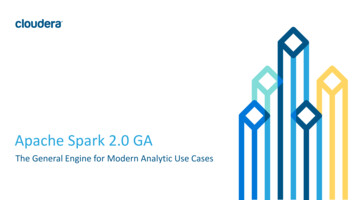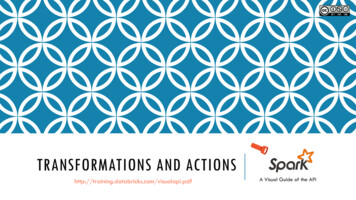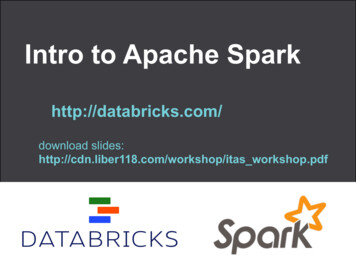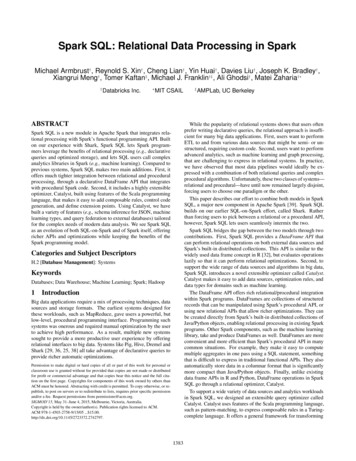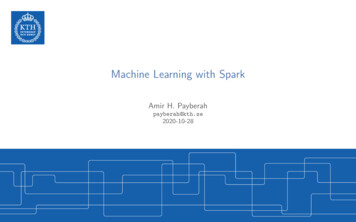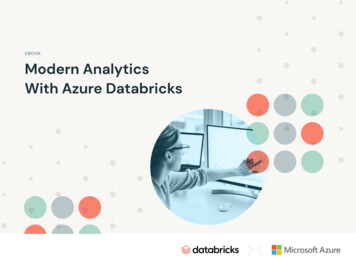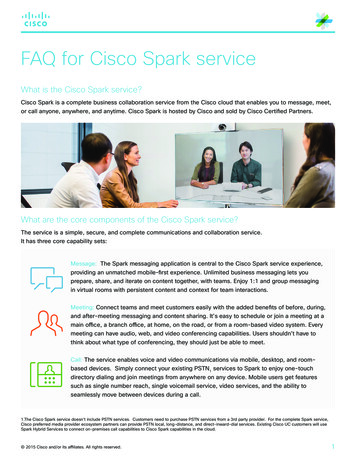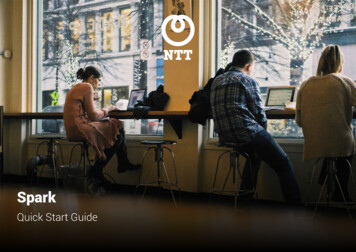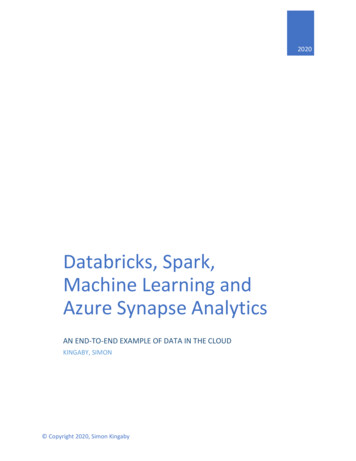
Transcription
2020Databricks, Spark,Machine Learning andAzure Synapse AnalyticsAN END-TO-END EXAMPLE OF DATA IN THE CLOUDKINGABY, SIMON Copyright 2020, Simon Kingaby
Databricks, Spark, Machine Learning and Azure Synapse AnalyticsTable of ContentsSummary . 3About the Author . 3Setup . 4Tools to Download and Install . 4Create some Azure Resources . 4Resource Group . 4Data Factory . 4Blob Storage . 4Data Lake. 5Key Vault . 5Application Insights . 6SQL Server . 6Databricks . 6Container Registry. 7Machine Learning. 7Exercise 1: Getting Some Data to Analyze . 9Exercise 2: Loading the Data Lake . 11Step 1: Upload the file to Blob storage . 11Step 2: Use Data Factory to Transfer the Blob to the Data Lake . 12Exercise 3: Processing the data in Databricks . 13Connecting to the Data Lake . 14Loading the Parquet File . 15Exercise 4: Creating the Machine Learning Model . 16Exercise 5: Detour Ahead! Create a Custom Docker Base Image . 18Install Docker Desktop on Your Local Machine . 18Clone and Modify a New Docker Image . 18To Edit the Docker Image . 19Exercise 6: Configure the Model for Deployment . 20Exercise 7: Build and Deploy the Docker image. 23Exercise 8: Testing the Webservice. 24A couple of things to know . 26Exercise 9: Loading the Data Warehouse . 27@Copyright 2020, Simon KingabyPage 1
Databricks, Spark, Machine Learning and Azure Synapse AnalyticsCreate the Data Warehouse . 27Create the Databricks ETL Script . 28Connect to the DW and Create the Target Tables . 30Back to Data Factory to Load the DW . 31Exercise 10: Creating a Power BI Report . 32@Copyright 2020, Simon KingabyPage 2
Databricks, Spark, Machine Learning and Azure Synapse AnalyticsDatabricks, Spark, Machine Learning andAzure Synapse AnalyticsAn End-To-End Example of Data in The CloudSummaryYou've heard about Azure Data Lake and Azure Data Warehouse, now called Azure Synapse Analytics.You've also heard about Azure Data Factory and Azure Data Bricks. You might even have heard aboutPython, Spark, and Azure Machine Learning. In this fast-paced, all-demo session, we will walk throughthe process of ingesting data into the Data Lake with Data Factory, analyzing it in Databricks with Sparkand Machine Learning, outputting the resulting model as a Docker image, running the model against aprediction dataset and saving it to the Data Warehouse and reporting on it in Power BI. You will walkaway with working code and an overall understanding of how all these tools can help you developadvanced analytics solutions in the modern data landscape.About the AuthorSimon Kingaby has been wrangling data for 20 plus years. For the past 5 years he’s been moving data tothe cloud from DB2, Oracle, Netezza and SQL Server. Now on the Big Data team at Deloitte Global, he’smoving data from on-prem data sources up to a Data Lake and then slice and dicing it throughDatabricks into a Machine Learning model and on to the Data Warehouse where the data is presented inPower BI. Simon also teaches the Data Analysis and Visualization Bootcamp at Vanderbilt University,has published several Alexa skills, and regularly speaks at conferences.@Copyright 2020, Simon KingabyPage 3
Databricks, Spark, Machine Learning and Azure Synapse AnalyticsSetupBefore working with the exercises in this document, we need to set up the Azure environment.If you do not have an Azure account, sign up for one. (https://azure.microsoft.com/en-us/free/)If you have an MSDN subscription, you can use the Azure account associated with it.Many of the resources we will create have an associated charge for use. The worst is the DataWarehouse which has an hourly rate just for existing. While the total cost of completing these exercisesshould be less than 50, this is not guaranteed. If nothing else, you will definitely want to delete the DWinstance when you are done.Tools to Download and InstallIn order to complete the exercises, you will need to upload a file to the Data Lake, this requires theMicrosoft Azure Storage Explorer. -explorer/Create some Azure ResourcesFirst things first, you will want all the exercise created items to be in a single, new Resource Group sothat you can delete the Resource Group when you are done (and stop the charges against your Azureaccount). You will also want to create several resources, detailed below, in the new Resource Group.Resource Group1. Create a new Resource Group to put all the exercise work in.a. In the Azure Portal, click on Resource Groups on the sidebar.b. Click the Add button.c. Give it a name in the Resource group box and click Review Create at the bottom.d. Then click Create at the bottom.Data Factory2. Create a Data Factorya. Open the Resource Group you created above.b. Click the Add buttonc. Search for Data Factoryd. Select the Data Factory optione. Click Createf. Enter a name for your data factoryg. Select the right subscriptionh. Pick the resource group you created abovei. Select a Locationj. Uncheck the Enable GIT boxk. Click CreateBlob Storage3. Create a Blob Storage Account in the North Central US regiona. Open the Resource Group you created above.@Copyright 2020, Simon KingabyPage 4
Databricks, Spark, Machine Learning and Azure Synapse Analyticsb.c.d.e.f.g.h.i.j.k.l.m.n.o.Click the Add buttonSearch for StoragePick Storage AccountClick CreateSelect the right subscriptionPick the resource group you created aboveEnter a Storage account nameSelect the North Central US Location (this is necessary for the ML exercise)Select Standard PerformanceSelect Account kind: BlobStorageSelect Locally-redundant Storage (LRS)Select the Cool Access tierClick Review CreateClick CreateData Lake4. Create an Azure Data Lake Gen 2 Storage Accounta. Open the Resource Group you created above.b. Click the Add buttonc. Search for Storaged. Pick Storage Accounte. Click Createf. Select the right subscriptiong. Pick the resource group you created aboveh. Enter a Storage account namei. Select any Locationj. Select Standard Performancek. Select Account kind: StorageV2l. Select Locally-redundant Storage (LRS)m. Select the Hot Access tiern. Click Next: Networkingo. Click Next: Advancedp. Enable Data Lake Storage Gen2 Hierarchical namespaceq. Click Review Creater. Click Creates. Once the resource is created t. Click the Containers buttonu. Click File systemv. Create a crime containerKey Vault5. Create a Key Vault in the North Central US regiona. Open the Resource Group you created above.b. Click the Add buttonc. Search for Vaultd. Choose Key Vault@Copyright 2020, Simon KingabyPage 5
Databricks, Spark, Machine Learning and Azure Synapse Analyticse.f.g.h.i.j.k.Click CreateSelect the right subscriptionPick the resource group you created aboveGive it a nameSelect the North Central US RegionSelect the Standard pricing tierClick CreateApplication Insights6. Create an Application Insights resource in the North Central US regiona. Open the Resource Group you created above.b. Click the Add buttonc. Search for Application Insightsd. Click Createe. Select the right subscriptionf. Pick the resource group you created aboveg. Give it a nameh. Select the North Central US Regioni. Click CreateSQL Server7. Create a SQL Server (logical server)a. Open the Resource Group you created above.b. Click the Add buttonc. Search for SQL Serverd. Choose SQL Server (logical server)e. Click Createf. Select the right subscriptiong. Pick the resource group you created aboveh. Give it a namei. Select a Locationj. Create a Server admin login and password and add them as Secrets to the Key Vaultk. Click Next: Networkingl. Change the Allow Azure Services to access this server to Yesm. Click CreateDatabricks8. Create a Databricks Servicea. Open the Resource Group you created above.b. Click the Add buttonc. Search for Databricksd. Choose Azure Databrickse. Click Createf. Give it a nameg. Select the right subscriptionh. Pick the resource group you created above@Copyright 2020, Simon KingabyPage 6
Databricks, Spark, Machine Learning and Azure Synapse Analyticsi.j.k.l.Select a LocationPick the Standard Pricing TierLeave the Deploy Databricks in your own VNet at NoClick CreateContainer Registry9. Create a Container Registrya. Open the Resource Group you created above.b. Click the Add buttonc. Search for Container Registryd. Choose Container Registrye. Click Createf. Give it a nameg. Select the right subscriptionh. Pick the resource group you created abovei. Select a Locationj. Do Enable the Admin Userk. Pick the Basic SKUl. Click CreateMachine Learning10. Create a Machine Learning service BUT NOT THROUGH THE PORTALa. Instead, open the Azure Cloud Shell in the browser:b. Then, select a Bash prompt. If you’ve never used the Cloud Shell, follow the promptsto set up a new storage account to use for the Shell.c. Afterwards, the Shell will load:d. Enter:az logine. Follow the instructions to login.@Copyright 2020, Simon KingabyPage 7
Databricks, Spark, Machine Learning and Azure Synapse Analyticsf.g.h.i.j.k.l.m.n.o.p.q.r.Enter the following commands:az extension add -n azure-cli-mlaz extension add -n application-insightsNow enter this to set the default subscription:az account set -s " Subscription Name "Then, enter this to make sure that the Container service is registered:az provider show -n Microsoft.ContainerInstance -o tableIf the table that dispays shows the RegistrationState is Not Registered, then enter:az provider register -n Microsoft.ContainerInstanceNow, enter this to get the storage account’s id:az storage account show --name storage-account-name --query"id" --resource-group resource-group-name Where storage-account-name is the Blob Storage account you created earlier.Copy the ID to a notepad window. It will look like Storage/storageAccounts/omwtmmlstorage"Enter:az monitor app-insights component show --app appinsightsaccount-name --query "id" --resource-group resource-groupname Where appinsights-account-name is the Application Insights account youcreated earlier.Copy the ID to the notepad window.Enter:az keyvault show --name key-vault-name --query "id" -resource-group resource-group-name Where key-vault-name is the Key Vault you created earlier.Copy the ID to the notepad window.Enter:az acr show --name container-registry-name --query "id" -resource-group resource-group-name Where container-registry-name is the Container Registry you created earlier.Copy the ID to the notepad window.Now, in the notepad window, assemble the following statement and then enter it inthe console:az ml workspace create -w workspace-name -g resource-groupname -l northcentralus --keyvault " key-vault-ID " -application-insights " app-insights-ID " --storage-account" storage-account-ID " --container-registry " containerregistry-ID" With (almost)1 all our resources configured, we can proceed through the Exercises.1We’ll be adding a Data Warehouse later on, but everything else is configured.@Copyright 2020, Simon KingabyPage 8
Databricks, Spark, Machine Learning and Azure Synapse AnalyticsExercise 1: Getting Some Data to AnalyzeThe FBI has some really cool Crime data that is relatively accessible through its Uniform Crime Reportingprogram: https://www.fbi.gov/services/cjis/ucr/For an example of how the Crime data is used, check out the Crime Data explorer/state/tennessee/The real goldmine is in the Downloads and Documentation page of the Crime Data downloads-and-docsHere, you can download incident-based data by stateand year. I downloaded, Tennessee data for 2009 to2018. However, in 2016, they changed the fileformats so I ended up only loading data from 2009 to2015.NOTE: If you don’t want to go through thisExercise, you can simply download therequired CSV file from my 020/01/crimeoverview100k.zipUnzipping one of the files, you find a sqlite setup.sqlfile and a sqlite load.sql script.Download and install SQLite, if you don’t already have SQLiteStudio-3.2.1.exeAt a command prompt, enter:sqlite3 your db name.db sqlite create.sqlThen to load in data into the database, run the following in each extracted zipfile of data you havedownloadedsqlite3 your db name.db sqlite load.sqlYou can create a batch file to load all the unzipped files into one database:cd TN-2010sqlite3 .\Crime.db sqlite load.sqlcd .cd TN-2011sqlite3 .\Crime.db sqlite load.sqlcd .cd TN-2012sqlite3 .\Crime.db sqlite load.sqlcd .cd TN-2013sqlite3 .\Crime.db sqlite load.sqlcd .cd TN-2014sqlite3 .\Crime.db sqlite load.sqlcd .Once the data is loaded, use SQLite Studio to create a view to bring all the data together:@Copyright 2020, Simon KingabyPage 9
Databricks, Spark, Machine Learning and Azure Synapse Analyticscreate view CrimeOverviewasselectm.data year as year, m.month num as month,ifnull(off age.age name, 'Unknown') as off age name,off.age num as off age,ifnull(off ethnicity.ethnicity name, 'Unknown') as off ethnicity name,case off.sex code when '' then 'U' else ifnull(off.sex code, 'U') end as off sex,ifnull(off race.race desc, 'Unknown') as off race,i.incident date,i.incident hour,ot.offense name,ot.crime against,ot.offense category name,ul.suspect using name,ifnull(wt.weapon name, 'Unknown') as weapon name,c.state abbr as state,vt.victim type name,v.age num as victim age,ifnull(victim age.age name, 'Unknown') as victim age name,ifnull(victim race.race desc, 'Unknown') as victim race,case (v.sex code) when '' then 'U' else ifnull(v.sex code, 'U') end as victim sex,ifnull(victim ethnicity.ethnicity name, 'Unknown') as victim ethnicity name,ifnull(r.relationship name, 'Unknown') as off vic relationship name,ifnull(cir.circumstances name, 'Unknown') as victim circumstances name,ifnull(injury.injury name, 'Unknown') as victim injury name,ifnull(jf.justifiable force name, 'Unknown') as victim justifiable force name,ifnull(loc.location name, 'Unknown') as location type name,ifnull(cat.criminal act name, 'Unknown') as criminal act type name,ifnull(bias type.bias name, 'Unknown') as bias type namefromnibrs incident ileft join nibrs month mon i.nibrs month id m.nibrs month idleft join nibrs offender offon i.incident id off.incident idleft join nibrs age off ageon off.age id off age.age idleft join ref race off raceon off.race id off race.race idleft join nibrs ethnicity off ethnicityon off.ethnicity id off ethnicity.ethnicity idleft join nibrs offense oon i.incident id o.incident idleft join nibrs offense type oton o.offense type id ot.offense type idleft join nibrs suspect using suon o.offense id su.offense idleft join nibrs using list ulon su.suspect using id ul.suspect using idleft join nibrs weapon won o.offense id w.offense idleft join nibrs weapon type wton w.weapon id wt.weapon idleft join cde agencies con i.agency id c.agency idleft join nibrs victim v@Copyright 2020, Simon KingabyPage 10
Databricks, Spark, Machine Learning and Azure Synapse Analyticson i.incident id v.incident idleft join nibrs victim type vton v.victim type id vt.victim type idleft join nibrs age victim ageon v.age id victim age.age idleft join ref race victim raceon v.race id victim race.race idleft join nibrs ethnicity victim ethnicityon v.ethnicity id victim ethnicity.ethnicity idleft join nibrs victim offender rel relon off.offender id rel.offender idand v.victim id rel.victim idleft join nibrs relationship ron rel.relationship id r.relationship idleft join nibrs victim circumstances victim ciron v.victim id victim cir.victim idleft join nibrs circumstances ciron victim cir.circumstances id cir.circumstances idleft join nibrs victim injury victim injuryon v.victim id victim injury.victim idleft join nibrs injury injuryon victim injury.injury id injury.injury idleft join nibrs justifiable force jfon victim cir.justifiable force id jf.justifiable force idleft join nibrs location type locon o.location id loc.location idleft join nibrs criminal act caon o.offense id ca.offense idleft join nibrs criminal act type caton ca.criminal act id cat.criminal act idleft join nibrs bias motivation biason o.offense id bias.offense idleft join nibrs bias list bias typeon bias.bias id bias type.bias idThen export the results of the view to a standard csv file.Exercise 2: Loading the Data LakeHere we will use the Azure Storage Explorer to upload the data file to Blob storage, then we will useAzure Data Factory (ADF) to load the file into the Data Lake. This exercise could be simplified by justuploading the file to the Data Lake using Storage Explorer, but in the interest of learning how, we willuse ADF, which is more likely in a real-world example.Step 1: Upload the file to Blob storageSince we’re simulating the process of loading data, we’re going to just use the Azure Portal to upload thecsv file created in Exercise 1 to Blob storage in Azure.First, in the Azure Portal, open the Blob Storage account you created in the Setup section.1.2.3.4.Click the big Containers button on the Blob Storage overview.Click Container to add a new container.Give it a name (such as, input)Set it to Private (no anonymous access)@Copyright 2020, Simon KingabyPage 11
Databricks, Spark, Machine Learning and Azure Synapse Analytics5. Click OK.Second, open the newly created container:1. Click the Upload button.2. Locate the csv file you created or downloaded and unzipped in Exercise 1.3. Click Ok. Click Upload.Step 2: Use Data Factory to Transfer the Blob to the Data LakeTypically, you will use Data Factory as your ETL tool to load data into the Data Lake where the data isstaged for further processing with Databricks.In Data Factory, click Author & Monitor, then select the Author button on the left.First, let’s set up two .17.Select Connections in the bottom left corner.Click NewSelect Azure Blob StorageGive your connection a nameSelect Account Key for Authentication MethodSelect your SubscriptionSelect your Blob Storage AccountClick Test connectionClick CreateClick New againSelect Azure Data Lake Storage Gen2Give your connection a nameSelect Account Key for Authentication MethodSelect your SubscriptionSelect your ADLS Storage AccountClick Test connectionClick CreateSecond, let’s create two Datasets:1.2.3.4.5.6.7.8.Next to the filter box, click the and select Dataset.Choose Azure Blob Storage as the data storeClick ContinueChoose DelimitedText as the formatClick ContinueGive the Dataset a nameSelect your Blob Storage linked serviceUnder File path, browse to select the Container name you uploaded the file to and then selectthe csv file you uploaded9. Check the First row as header box10. Click OK11. Click on the Connection tab@Copyright 2020, Simon KingabyPage 12
Databricks, Spark, Machine Learning and Azure Synapse .Click the Preview data buttonIf that works, go on to the next stepCreate the second Dataset. Next to the filter box, click the and select Dataset.Select Azure Data Lake Storage Gen2Click ContinueSelect Parquet (a common file format for the Data Lake and Databricks)Click ContinueGive your Dataset a nameSelect the Data Lake connectionEnter crime for the File SystemLeave the Directory blankEnter CrimeOverview.parquet as the FileLeave Import schema at NoneClick OKThird, we’ll create the copy pipeline:1.2.3.4.5.6.7.8.9.10.11.12.Next to the filter box, click the and select Pipeline.Give your Pipeline a nameIn the center, under Move & transform, drag a Copy data task into the PipelineGive the Copy task a nameSelect the Source tabSelect the csv DatasetUncheck the Recursively checkboxSelect the Sink tabSelect the parquet DatasetSelect the Mapping tabClick Import schemasAt this point, you could clean up the data types, we’re going to leave them all as strings and dealwith the data types in DatabricksFinally, click the Publish All button to Publish everything to the Data Factory.Then trigger the copy pipeline by selecting Add trigger, Trigger now. After it has spun up, you can seethe progress by selecting the Monitor button on the left.Exercise 3: Processing the data in DatabricksNow we have the data as a parquet file in the Data Lake. We need to load the data into some tool,parse, filter and shape it, then load it into a Machine Learning model for analysis.One tool (among many), that we can do this with is Databricks. It has native support for parquet filesand provides access to the Spark Machine Learning libraries.First, open the Databricks service you created earlier. Click the Launch Workspace button in the middleof the Overview page.Next, click on the Clusters icon on the left.@Copyright 2020, Simon KingabyPage 13
Databricks, Spark, Machine Learning and Azure Synapse .Click Create ClusterGive your cluster a namePick Standard as the Cluster ModePick None for PoolPick Runtime: 6.2 (Scala 2.11, Spark 2.4.4)Uncheck the Autoscaling checkboxChange the Terminate timeout to 30 minutesLeave the Worker Type at Standard DS3 v2Decrease the number of Workers to 2Click Create Cluster at the topNow, select the cluster to open it.Select the Libraries tabClick Install NewPick PyPi as the library sourceEnter azureml-sdk[databricks] as the Package nameLeave Repository blankClick InstallNow, while that’s all spinning up, click on the Workspace icon on the left.1.2.3.4.Right-click on the whitespace under the Workspace heading and pick Create Notebook.Give the Notebook a nameMake sure that Python is selected for the LanguageClick CreateDatabricks notebooks are very similar to Jupyter notebooks. You type code into the box (called a Cell)and run it by pressing Ctrl-Enter or clicking the Play button.The notebook keeps the context from each Cell for use in other Cells. Using a notebook, you can code abit, run a bit, code a bit, run a bit, and so on.Connecting to the Data LakeThe first thing we need to do is bring in the data. For this, we need to connect the notebook to the DataLake. For that we need an access key2:1.2.3.4.5.Open the Data Lake in another tabSelect Access keysCopy key1 to the clipboardSwitch back to the notebookIn the first cell, enter this code:adl key " paste in Data Lake Access Key here"2Access keys are nowhere near as secure as other methods for connecting to a Data Lake. However, most of thoserequire upgrading to Premium services. So, for the sake of simplicity, we’ll just be using the key. At the very least,you should follow these instructions to connect your Databricks environment to an Azure Key Vault and store theAccess key there.@Copyright 2020, Simon KingabyPage 14
Databricks, Spark, Machine Learning and Azure Synapse Analyticsspark.conf.set("fs.azure.account.key. insert data lake name .dfs.core.windows.net", adl key)6. Press ctrl-enter to run the codeAfter some time, the notebook will have spon up the cluster, submitted the code to the cluster andexecuted it. You should get some feedback that the Command took 0.10 seconds or so.Now we have a connection between the notebook/cluster and the Data Lake.Loading the Parquet FileIn the next cell, enter and execute the following code to display the files from the crime File System inthe Data Lake:src "abfss://crime@ insert data lake name .dfs.core.windows.net/"dbutils.fs.ls(src)abfss is a special protocol that tells the cluster to look in the Data Lake for a file.Now that we can see the file we transferred into the Data Lake, we can load it into a Spark View (whichis a type of temp table). Enter and execute the following code:spark.read.parquet(src rview")And to see the data in the Spark View, we can use Spark SQL. Enter and execute the following code:df spark.sql("""select cast(year as int) year, cast(month as int) month,cast(off age as int) off age,off sex, off race, cast(incident date as date) incident date,offense name,offense category name, suspect using name, weapon name, state,cast(victim age as int) victim age, victim sex, victim race,off vic relationship name, location type namefrom CrimeOverviewwhere crime against 'Person'and victim type name 'Individual'and off age name 'Age in Years'and victim age name 'Age in Years'and off sex 'U' and off race 'Unknown'and victim sex 'U'and victim race 'Unknown' """)df df.dropna() # drops any rows with null values in themdf.head()@Copyright 2020, Simon KingabyPage 15
Databricks, Spark, Machine Learning and Azure Synapse AnalyticsFinally, let’s cut down the resultset to just the columns we’re going to need for the Machine Learningexercise. Enter and execute this code:colsToKeep ['year', 'month', 'victim age', 'victim sex', 'offense category name', 'location type name', 'off vic relationship name']df2 df.select(*colsToKeep)df2.head()And that’s it. You’ve loaded the data into a Spark dataset ready for running through the MachineLearning model, which is the next exercise.Exercise 4: Creating the Machine Learning ModelIf you’re not familiar with Machine Learning, then this exercise will likely be Greek to you. However, Ihave tried to add comments to the code to explain what is going on.Basically, we would like the Machine to predict what the relationship between the offender and thevictim is most likely to be, given a specific month (year and month), a specific victim (age and sex), anoffense category and a location.For example, if
Databricks, Spark, Machine Learning and Azure Synapse Analytics An End-To-End Example of Data in The Cloud Summary You've heard about Azure Data Lake and Azure Data Warehouse, now called Azure Synapse Analytics. You've also heard about Azure Data Factory and Azure Data Bricks. You might even have heard ab
